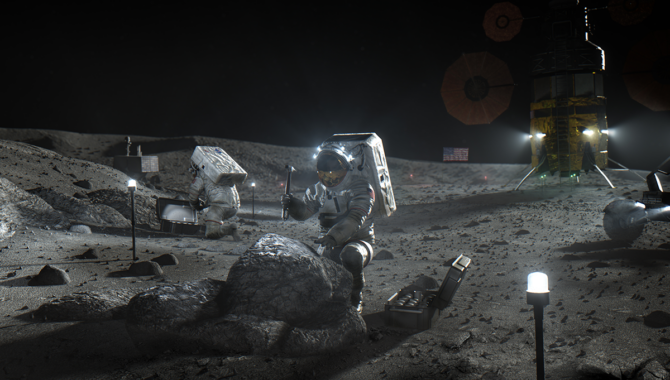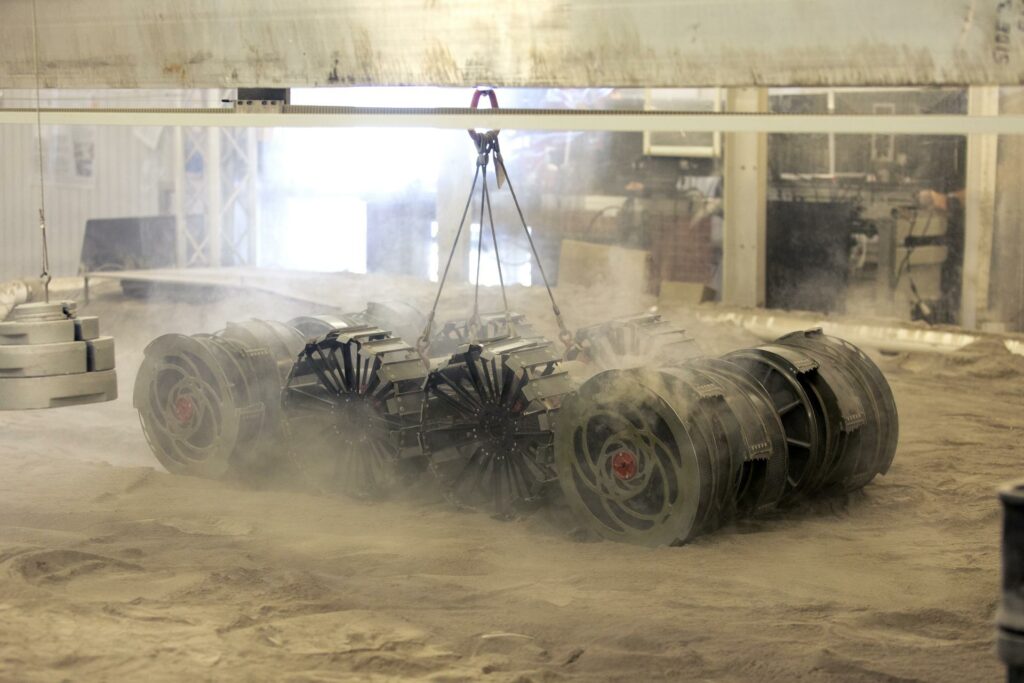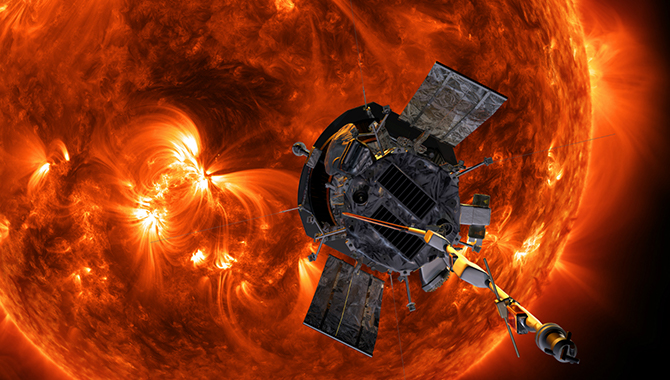
With the Artemis missions, NASA intends to create a blueprint for sustained human presence and exploration throughout the solar system. In this artist’s illustration, Artemis astronauts work on the lunar surface.
Credit: NASA
NASA aims to create a blueprint for sustained human exploration of solar system.
When Artemis III astronauts land on the lunar surface later this decade, they will do so supported by the most advanced space exploration architecture ever developed—rockets, spacecraft, rovers, spacesuits, communications relays, power systems, and more—with some components supplied by international and commercial partners.
This architecture will support the pursuit of 63 top-level objectives and corresponding goals NASA developed with input from commercial partners, academic institutions, international space agencies, and the NASA workforce. The objectives include advances in lunar and planetary science, heliophysics, physics, biology, and applied science, as well as the development of the infrastructure, transportation, and habitation that will support long-term exploration of the Moon and later Mars.
“When we went for Apollo, … we were following a mission to send a man to the Moon and return him safely to the Earth, and we found incredible scientific riches on the Moon,” NASA Deputy Administrator Pam Melroy said, speaking at the Space Foundation’s 38th Annual Space Symposium in Colorado Springs, Colorado. “Now we need to take a different approach. Science needs to be front and center in what our astronauts are doing just the same way it is on the International Space Station.”
“Our goal is to create a blueprint for sustained human presence and explorations throughout the solar system…”
During her keynote address on April 18, Melroy announced the release of results from a comprehensive Architecture Concept Review NASA performed to examine how current Moon to Mars activities align with those objectives.
“Our goal is to create a blueprint for sustained human presence and explorations throughout the solar system. We believe this is what the American people expect of us. This is what we have dreamed about for years, decades, maybe even millennia. Going out to explore, because, after all, humans are a society of wanderers and explorers. It’s in our DNA,” Melroy said.
One of the keys to this blueprint is to build the capacity for longer stays on the lunar surface. During Apollo 17, Eugene A. Cernan and Harrison H. Schmitt set a record by spending a little over three days on the Moon, 22 hours of which were spent exploring the lunar surface.

A team from the Granular Mechanics and Regolith Operations Lab tests the Regolith Advanced Surface Systems Operations Robot (RASSOR) in the regolith bin inside Swamp Works at NASA’s Kennedy Space Center in Florida on June 5, 2019. Tests use a gravity assist offload system to simulate reduced gravity conditions found on the Moon. On the surface of the Moon, mining robots like RASSOR will excavate the regolith and take the material to a processing plant where usable elements such as hydrogen, oxygen and water can be extracted for life support systems. RASSOR can scoop up icy regolith which can be used to make operations on the Moon sustainable.
Credit: NASA/Kim Shiflett
“I just want to emphasize how much we want to get science return out of what we’re doing,” Melroy said. “Now, you’re going to send astronauts three or four days on a trip to the Moon, 30 days of science on the Moon, and then three or four days back. That’s a pretty good return on investment for science.
“Anywhere else in the solar system, it’s not going to work, right? We’re talking a two-year journey or longer for a 30 day or less stay. So, that’s okay for a test flight, but we have to have the infrastructure that supports humans for a sustained presence to really maximize the value… We really need to be able to stay. And so that infrastructure is a critical element of our architecture, the communications, the power, landing pads, all kinds of infrastructure.”
An illustration depicting one of ICON’s construction technologies that could help build infrastructure such as landing pads, habitats, and roads on the lunar surface.
Credit: Credits: ICON/BIG-Bjarke Ingels Group
The analysis of space systems architecture hinges on six questions: “who,” “what,” “where,” “when,” “why” and “how?” The Apollo program famously focused on “when”—the end of the 1960s. The program was characterized by rapid technical advances, but the architecture wasn’t especially flexible.
By focusing first on the “why” and then the “what,” the objective-based approach NASA is using for Artemis enables the agency to work backwards from the defined goal, developing the elements necessary for success in an integrated manner. It also helps internal and external stakeholders maintain a clear and consistent understanding of the purpose of the architecture.
In addition to the Architecture Concept Review, NASA also released supporting white papers that highlight key Moon to Mars topics, such as the selection of a Near Rectilinear Halo Orbit for Artemis missions, what drove the landing site selection, and the role the Gateway will serve in establishing a long-term human presence at the Moon. The topics are:
- Systems Analysis of Architecture Drivers
- Why NRHO: The Artemis Orbit
- Why Artemis will Focus on the Lunar South Polar Region
- Gateway: The Cislunar Springboard for International and Sustainable Human Deep Space Exploration
- Mars-Forward Capabilities to be Tested at the Moon
- Moon to Mars Architecture
“So, from my standpoint, this first architecture concept review is very exciting,” Melroy said. “It’s the bridge between the objectives that we developed with our partners and decomposing them into an architecture with requirements… This is a critical milestone for us in our Moon to Mars strategy.”









